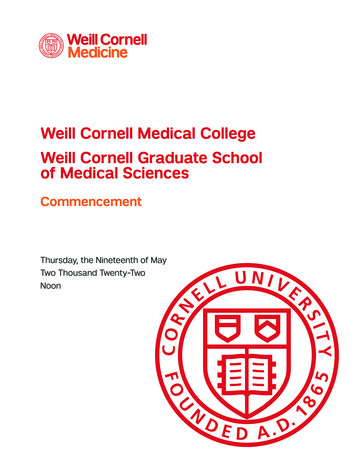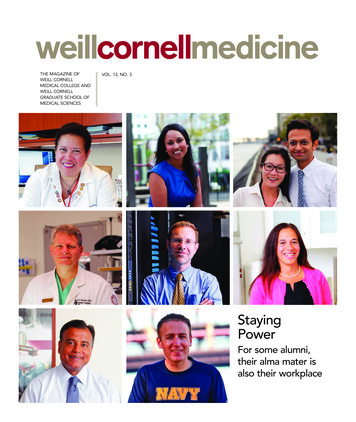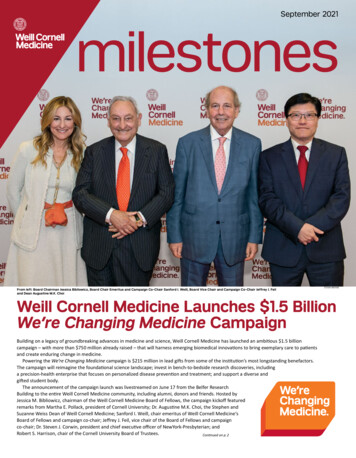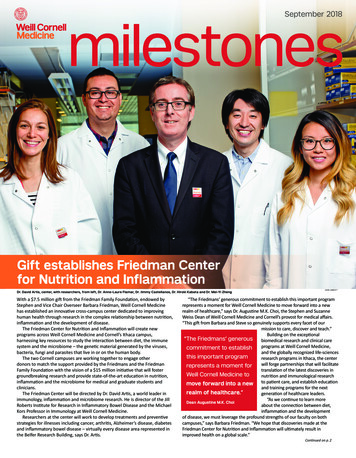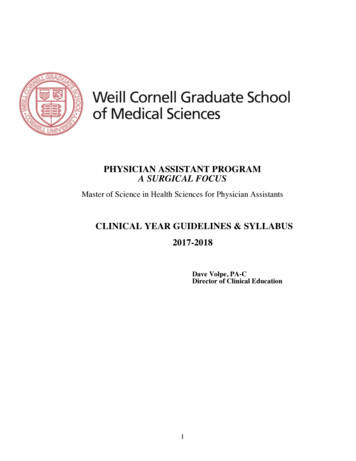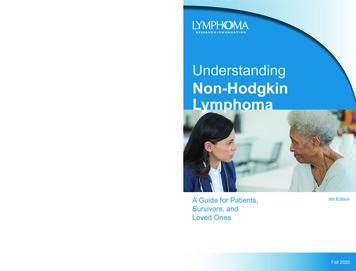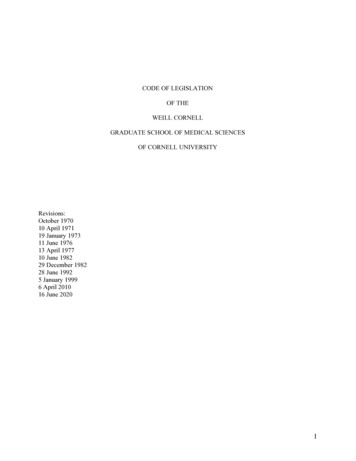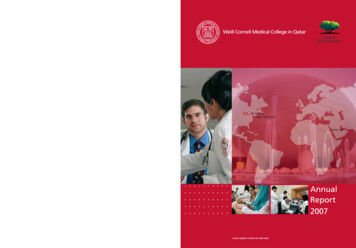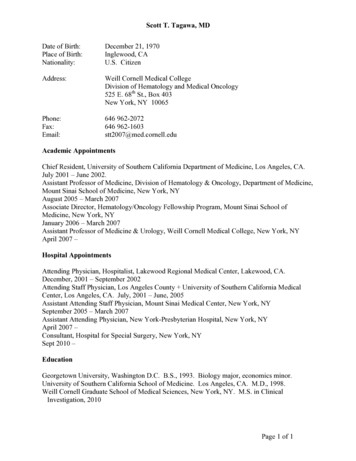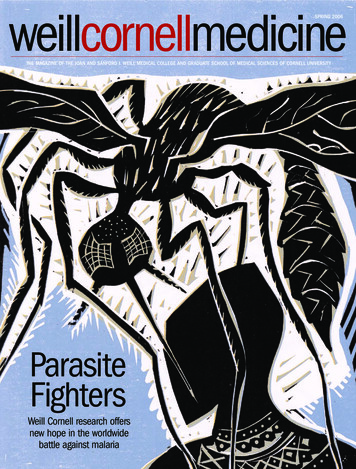
Transcription
SPRING 2006weillcornellmedicineTHE MAGAZINE OF THE JOAN AND SANFORD I. WEILL MEDICAL COLLEGE AND GRADUATE SCHOOL OF MEDICAL SCIENCES OF CORNELL UNIVERSITYParasiteFightersWeill Cornell research offersnew hope in the worldwidebattle against malaria
WEILL MEDICAL COLLEGEOFCORNELL UNIVERSITYOFFICE OF ALUMNI RELATIONSSave the Date2006 ReunionOctober 13-14, 2006A time to renew old friendships, take a stroll down memory lane and hearfirst hand about the exciting work in progress at your outstanding alma mater.All alumni of the Medical College, Graduate School of Medical Sciencesand Center Alumni Council are welcome!5th2000200110th19951996Special h19701971Induction of the 50th & Golden Anniversary Classes55th1950195160th19451946To help us plan reunion activities that you will most enjoy, please visit our website atwww.med.cornell.edu/alumni and complete the Reunion 2006 questionnaire.Join us October 13-14 in celebrating memorable times!Weill Medical College of Cornell University Office of Alumni Relations418 East 71st Street, Suite 31 New York, NY 10021212-746-6546T( elephone) 212 -746-8341F( i
weillcornellmedicineTHE MAGAZINE OF THE JOAN AND SANFORD I. WEILL MEDICAL COLLEGE AND GRADUATE SCHOOL OF MEDICAL SCIENCES OF CORNELL UNIVERSITY2 DEANS MESSAGESComments from Dean Gotto & Dean Hajjar4 SCOPEGoing for three. Plus: New vice dean,public health professorships, kudos forDr. Rosenfeld, and farewells to Dr. Barnesand Dr. Kernberg.18 SMALL WONDER18SHARON TREGASKISAs the technology for keeping premature babies alive has improved, the threshold ofviability for the tiniest infants has crept down to twenty-four weeks—before lungs aremature and brains are fully developed. At Weill Cornell’s neonatal intensive care unit,exploring that dangerous frontier of life is the job of doctors who must balance thelong-term implications of their interventions with the hopes of family members whoask for—and sometimes receive—miracles.269 TALK OF THE GOWN26 FEVER PITCHC. A. CARLSONMalaria—once the target of worldwide eradication efforts that all but eliminated thedisease from the developed world—now kills 2,000 children a day in Africa alone. Amajor grant from the Bill & Melinda Gates Foundation has brought the disease backinto the headlines, but Weill Cornell researchers have long battled the resourcefulparasite. Now they are bringing the latest tools from genomics and immunology tobear in the struggle against one of humanity’s most ancient and lethal foes.40 NOTEBOOKNews of medical college alumniand graduate school alumni47 IN MEMORIAM34 ALTER EGOSAlumni rememberedBETH SAULNIEREarly morning and after hours, Weill Cornellians manage of find the time to expressthe sides of their lives outside of medicine.The hobbies, sidelines, and assorted consuming passions of these weekend warriors include creating online artinstallations, figure skating, singing ingospel-bluegrass groups, climbing frozenwaterfalls, and practicing bharatnatyam, a classical southern Indian dance.The decider. Plus: Culture clash,a back breakthrough, a surgeonon the edge, and sex ed fornervous parents.48 POST-DOCThe road to Doha34Cover illustration by Raymond VerdaguerWeill Cornell Medicine (ISSN 1551-4455) is produced four times a year by Cornell Alumni Magazine, 401 E. State St., Suite 301, Ithaca, NY 14850-4400 for the Joan and Sanford I.Weill Medical College and Graduate Schoolof Medical Sciences of Cornell University. Third-class postage paid at New York, NY, and additional mailing offices. POSTMASTER: Send address changes to Public Affairs, 525 E. 68th St. Box 144, New York, NY 10021.SPRING 20061
dEANS mESSAGESFROM 1300 YORK AVENUEThe Lifelong Pursuit of LearningANTONIO GOTTO JR., MDDean of the Medical CollegeI do solemnly vow . . . that I willrecognize the limits of myknowledge and pursue lifelonglearning to better care for the sickand to prevent illness.– Hippocratic Oath, Weill MedicalCollege of Cornell UniversitymEDICINE IS A DY-namic profession,defined by technological advances,research breakthroughs, and newprocedures that allow physicians tobetter fulfill their responsibilities topatients. As medical care becomesincreasingly sophisticated, a thorough education that inspires a lifelong enthusiasm for continuedlearning will play an even more crucial role in the lives of physicians.Each spring during commencement, I am reminded both of the responsibilities of physicians and of the role of education in the lives of teachers andstudents. In May, 101 graduates from the Medical Collegebegan their careers, leaving behind the classroom andadvancing their training as they took one step closer tobecoming attending physicians.The eagerness and excitement that our graduating students feel about the added responsibilities and opportunities of this next phase of their careers illustrate the valuesinstilled by Weill Cornell’s progressive approach of selfinquiry and active learning.One of the cornerstones of Weill Cornell’s medical education is early exposure to one of the most diverse patientpopulations in the world. Students participate in clinicalrotations at a variety of public, community, and/or researchhospitals, including NewYork-Presbyterian Hospital/WeillCornell Medical Center, the Medical College’s chief clinicalpartner and one of the premier academic medical institutions in the country. With this background, and the MedicalCollege’s emphasis on small-group learning and problemsolving, our graduating medical students are well qualifiedto succeed in the challenges of their residency programs.The Class of 2006 continues Weill Cornell’s tradition2 WEILL CORNELL MEDICINEof internationalism, with students originally from SaudiArabia, Mexico, and Ukraine, among other countries. Thisyear ’s class also has three students who entered medicalschool with advanced degrees: two with doctorates of philosophy and one with a doctorate of jurisprudence. Anotherten students will graduate this year with two advanceddegrees as part of the Medical College’s Tri-InstitutionalMD-PhD Program in partnership with the RockefellerUniversity and Memorial Sloan-Kettering Cancer Center.The diversity in educational backgrounds exemplifiesWeill Cornell students’ drive and pursuit of knowledge. Italso underscores their broad approach to practicing medicine, as they prepare themselves for professions not only intranslational medicine, but also for positions in health-careadministration and business.Commencement is also a chance to reflect on the joysof teaching. The dynamic exchange between student andteacher is at the foundation of a lifelong pursuit of learning.And that continual pursuit is one of the central tenets of acareer in medicine. As we bid farewell to the Class of 2006,we can be confident that they are well prepared to lead thenext generation of physicians.— Dean Antonio Gotto
The Next GenerationDAVID HAJJAR, PHDDean of the Graduate School of Medical SciencesoUR JUST-COMPLETED RECRUITMENT SEASONspeaks to the success the Graduate School hashad in recent years attracting outstanding students from top undergraduate institutions to pursue a doctoral degree with us. More than 100 studentsmade the trip to New York City in February to meet faculty and students, visit laboratories, and take in the sightsand sounds of New York City.Our recruits come to us with impressive records. Manyare completing their undergraduate studies at Ivy Leagueschools and have already done substantial research at thebench. Some have published papers. In every case, thesestudents are ready to take on the new challenges offered bythe Graduate School. They know that the rigorous curriculum, the challenging ACE examination, and the long hoursin the laboratory are part of the next phase of their scientific careers, and they come to Weill Cornell for the best training possible. Students arrive here prepared for hard work,and they join a unique community of scientists who sharetheir passion for research and commitment to making significant contributions to the biomedical enterprise.Feedback from our recruitment weekend consistentlyshows that students appreciate the breadth and depth ofour programs, as well as the collaborative atmosphere,which opens up possibilities for new discoveries. Studentsfeel they can make a real contribution at the GraduateSchool, where they will be encouraged by a faculty committed to the next generation of biomedical researchers.A student who applied to the Allied Program inBiochemistry & Structural Biology, Cell Biology &Genetics, and Molecular Biology (BCMB) this fall, summedit up nicely when he wrote, “[The Graduate School] . . . isreally the best of all possible worlds. The BCMB program isthe most diverse one I’ve seen, and I’m thrilled about thepotential to work in one of the many labs. This is the onlyplace I can see being happy.”Ryan Heller, who is in his final year in the BCMB program, would surely endorse that notion. Here at theGraduate School, we were glad to learn that Ryan hasreceived the prestigious Harold M. Weintraub GraduateStudent Award from the Fred Hutchinson Cancer ResearchCenter. He traveled to Seattle to accept the award and presented his work to a scientific symposium honoring the lateDr. Weintraub, an internationally known scientist whosecontributions to molecular biology revolutionized biomed-ical research. The award was established in 2000 to recognize his work and celebrate the achievements of young scientists. It is given each year to only sixteen graduatestudents chosen for the quality, originality, and significanceof their scientific research.Although Dr. Weintraub was only forty-nine years oldwhen he died, he was known at the Hutchinson Center asboth a great scientist and a leader who nurtured otherresearchers, including graduate students, and created a collaborative environment to foster scientific breakthroughs.RICK DEWITTRyan HellerRyan benefited from a similar atmosphere during his fiveyears at the Graduate School. In fact, he singles out thatsupport as the strong suit of Weill Cornell. “The otherresearchers in the lab make it an incredible working environment,” he says. “We are able to discuss science and helpeach other by talking about results and coming up withnew ideas.”The Weintraub Award is one of the highest honors agraduate student can receive, and we congratulate RyanHeller on this recognition of his accomplishments.— Dean David HajjarSPRING 20063
sCOPENEWS BRIEFSAMELIA PANICODean GottoFive More YearsCohen Named Vice DeanR. ANTONIO GOTTO JR. HAS BEEN APPOINTED TO A THIRDTHE FORMER VICE PRESIDENT AND CHIEF FINANCIAL OFFICER OF THEfive-year term as dean of the Medical College. Anauthority on cardiovascular disease, Gotto was firstnamed to the post in 1997. During his tenure, theCollege’s growth has included the establishment of theQatar branch, construction of the new 230 millionAmbulatory Care and Medical Education Building, and the completion of a 750 million capital campaign, as well as the institution’srenaming in honor of benefactors Joan and Sanford Weill. Researchhas been expanded in such areas as stem cells, genetics, nanomedicine, and bioengineering; NIH funding has more than doubled,while faculty publication in peer-reviewed journals has tripled.A former Rhodes Scholar, Gotto is a past president of both theAmerican Heart Association and the International AtherosclerosisSociety. He has published more than 500 scholarly articles andbooks; his titles for a lay audience include The New Living HeartDiet and The Living Heart Cookbook. “With characteristic energy,integrity, and vision, he has strengthened the education and financial health of Weill Cornell, helping to revitalize the medicalschool’s curriculum, expand and improve facilities, and enhancepatient care,” says Cornell Board of Trustees chairman PeterMeinig. “And, in achieving these goals, he has forged partnershipsand expanded the scope of the Medical College locally, nationally,and internationally.”Howard Hughes Medical Institute has been named Weill Cornell’sassociate provost and executive vice dean for administration andfinance. Appointed in March, Stephen Cohen is the senior executive responsible for the day-to-daymanagement of the college’s nonacademic operations, reportingdirectly to Dean Gotto. He willserve as liaison to the financialand administrative offices ofCornell University, as well as to theadministration of NewYork-Presbyterian Hospital.Cohen holds a bachelor’sdegree from Pennsylvania StateStephen CohenUniversity and an MBA from NewWEILL CORNELL ART & PHOTOYork University. He succeedsSteven Rosalie, who has been appointed executive vice dean andassociate provost for international initiatives. Prior to his tenure atHughes, Cohen was associate dean for finance and administrationat the Yale University School of Medicine. Chairman of the Board ofOverseers Sanford Weill praised Cohen’s appointment, saying:“Steve Cohen is the right person with the right background to helpus meet the challenges ahead.”d4 WEILL CORNELL MEDICINE
Research & PreventionAN ASSISTANT PROFESSOR OF CLINICAL MEDICINE HAS BEEN NAMED TOa three-year term as the first Nanette Laitman Clinical Scholar. Theendowed professorship will allow Dr. Shari Midoneck, an attendingphysician at the Iris Cantor Women’s Health Center at NewYorkPresbyterian Hospital, to pursue clinical research in the area of preventive health.The 4 million Laitman Clinical Scholars Program in PublicHealth—made possible by a 3 million gift from the Laitman family and 1 million in matching funds from the Medical College—willultimately comprise endowed professorships in four fields: prevention, clinical evaluation, community health, and quality of careresearch. It is intended to give top junior faculty members theopportunity to meld their clinical expertise with public healthresearch. The professorships are named in honor of NanetteLaitman, the daughter of late Weill Cornell benefactors William andMildred Lasdon; she has followed in their footsteps as a major philanthropist, with a keen interest in public health.Honors for RosenfeldA WEILL CORNELL CARDIOLOGISTMARIE WALLACEwell known to TV audiences andnewspaper readers has receivedthe Greenberg DistinguishedService Award, the highest honorNewYork-Presbyterian Hospital bestows on its professional staff. Dr.Isadore Rosenfeld, the Rossi Distinguished Professor of ClinicalMedicine, is the author of severalbest-selling books, including WhatDr. Isadore RosenfeldShould I Eat? and Dr. Rosenfeld’sGuide to Alternative Medicine; heserves as health editor of Parade magazine and frequently offersexpert commentary on network TV news shows. The GreenbergAward includes a 50,000 grant made possible by an endowmentfrom Maurice Greenberg.Dr. William Barnes, 1912–2006DR. WILLIAM BARNES, A 1937 GRADUATE OF THE MEDICAL COLLEGE WHOtaught at Cornell for four decades, passed away on March 26 at ahospital near his home in Ho-Ho-Kus, New Jersey. He was ninety-four.Born in New York City in 1912, Barnes attended City Collegeand did his surgical residency at New York Hospital. He retired fromCornell in 1984 as a clinical professor emeritus of surgery, havingmentored countless medical students, residents, and younger colleagues. At his private practice on Manhattan’s Upper East Side,his prominent patients included cosmetics maven HelenaRubenstein and poet William Carlos Williams. He was active inalumni affairs, serving on the alumni association’s board of directors and chairing the Medical College Fund for more than twenty-five years; the college recognized his efforts in 1982, when it gavehim the Distinguished Alumnus award. In addition to his four children and seven grandchildren, he’s survived by his wife of sixtyyears, Dr. Shirley Mayer Barnes.Dr. Paulina Kernberg, 1935–2006DR. PAULINA KERNBERG, A CHILD PSYCHIATRIST WHO CAME TO NATION-al attention when she evaluated six-year-old Cuban refugee ElianGonzalez, died April 12 of bladder cancer at NewYork-PresbyterianHospital. She was seventy-one.An expert on the emotional effects of divorce on children—considering its trauma to be second only to the death of a parent—Kernberg helped found a clinical program for children of divorcedfamilies at NewYork-Presbyterian’s Westchester site. Her publications included the book Personality Disorders in Children andAdolescents.Kernberg was born in Santiago, Chile, and earned her medicaldegree from the University of Chile. She became an American citizen in 1968 and came to Cornell in 1978, directing the residencyprogram in child and adolescent psychiatry at the Westchester hospital. In 2000, the Immigration and Naturalization Service tappedher to assess Gonzalez, who was found adrift off the Florida coastafter his mother died trying to flee Cuba. He became the subject ofa bitter, highly publicized international custody battle between hisfather in Cuba and his relatives in Miami, and was eventuallyreturned to Cuba. Kernberg is survived by her husband of fifty-twoyears, Dr. Otto Kernberg, a Weill Cornell professor of psychiatry, aswell as three children and four grandchildren.Silver Named Associate DeanRANDI SILVER, A NOTED EXPERT ON THE RENAL SYSTEM AND CARDIACarrhythmia, has been named associate dean of the GraduateSchool of Medical Sciences. She is currently an associate professor of physiology and biophysics. “Dr.Silver has been on the faculty at theGraduate School since 1991, and shehas done a great job,” says Dean DavidHajjar. “I am looking forward to workingwith her on a daily basis.”After receiving her PhD from BrownUniversity, Silver completed a postdoctoral fellowship at the Graduate School. Shesubsequently became an instructor atDr. Randi Silverthe Medical College and rose to theWEILL CORNELL ART & PHOTOposition of associate professor in 1997.She is also a faculty member at the Marine Biology Laboratory inWoods Hole, Massachusetts and is on the editorial board of theAmerican Journal of Physiology–Renal Physiology.Correction—Winter 2006: The photo of Dr. Daniel Gardner on page4 was taken by Amelia Panico.SPRING 20065
from the benchthat even after adjusting for these factors, presence of strain wasstill associated with increased risk of CHF. The study’s other participating sites included hospitals in Michigan and Scandinavia.New Stent Combats StrokeSurgeons at NewYork-Presbyterian Hospital/Weill Cornell MedicalCenter are the first in the New York metropolitan area to successfully implant a new type ofstent designed to treat highrisk stroke patients who havenot responded to medicaltherapy. The Wingspan StentSystem is implanted in thebrain arteries of people diagnosed with intracranial atherosclerotic disease, or excess plaque buildup. It wasspecifically designed for thefragile vessels of the brain.The implantation procedure involves making anincision in the patient’sDr. Howard Riinafemoral artery; a balloon isthreaded through the vessels, expanded to crack the plaque, and then withdrawn; thestent is inserted in the plaque’s former location. According to Dr.Howard Riina, associate professor of neurological surgery, recentresearch has shown that a large percentage of patients withplaque buildup in the brain do not respond to medication.“Without any intervention,” he says, “these patients have a significant chance of having another stroke within a year.”Promising Treatment for ALSWEILL CORNELL ART & PHOTOThe drug thalidomide, once vilified for causing birth defects whenadministered to pregnant women, shows promise in the battleagainst amyotrophic lateral sclerosis (ALS). Studies on mice conducted by Weill Cornell neuroscientists have found that thalidomide and its derivative, lenalidomide, may extend the lives ofpatients with the disorder commonly known as Lou Gehrig’s disease. The results of the study, lead by neuroscience instructorDr. Mahmoud Kiaei, were published in the Journal of Neuroscience in March.More than 30,000 Americans, most of them between theages of forty and seventy, are living with ALS. The disease is uniformly fatal, and there is presently no effective treatment.Scientists are still working to understand its origins, though theysuspect that pro-inflammatory molecules called cytokines areinvolved, and that thalidomide and lenalidomide work to suppress them. “Treatment slowed the wasting and declines inmotor control that we typically see with ALS,” Kiaei says. “Wealso saw evidence of reduced neuronal death. Best of all, themice lived significantly longer than untreated mice.”B-vitamin Treats Fetal Alcohol Damage6 WEILL CORNELL MEDICINEA variant of vitamin B3 known as nicotinamide has been foundto reduce the molecular, cellular, and behavioral effects of fetalalcohol syndrome in mice, Weill Cornell scientists have found.The results, published in PLoS Medicine in February, could holdpromise as a preventative therapy to treat the syndrome inhumans; they could also have implications for children with otherneurological diseases, such as cerebral palsy. “Despite attemptsto increase awareness of fetal alcohol syndrome, consumptionof alcohol during pregnancy, especially binge drinking, hasincreased in recent years,”says assistant professor ofpsychiatry Dr. Daniel Herrera. He notes that there arecurrently no effective treatments for the condition,estimated to be the mostcommon, preventable causeof mental retardation in theWestern world.In the study, ethanol andnicotinamide were administered to mice seven daysafter birth, an age at whichDr. Daniel Herreratheir brain development isAMELIA PANICOAn electrocardiogram is an effective tool for detecting risk ofcongestive heart failure (CHF) in patients with hypertension, saysa study led by medicine professor Peter Okin, MD ’80. An analysis of nearly 8,700 hypertensive patients with no history of CHFfound that a unique and well-known ECG wave pattern called“strain” was present in 10.6 percentof subjects—tripling their risk of developing the condition over the next fiveyears and quadrupling their risk ofdying from it. The findings, Okin says,“suggest that more aggressive therapymay be warranted in hypertensivepatients with ECG strain” to reduce therisk of CHF.Researchers found that patientswho developed the condition were:Dr. Peter Okinolder than those who did not; morelikely to have diabetes and a prior history of ischemic heart disease, heart attack, stroke, and peripheral vascular disease; more likely to be black; more likely to beoverweight; and more likely to be current smokers. They foundAMELIA PANICO‘Strain’ Signals Congestive Heart Failure
comparable to the human third trimester. Researchers found thatthe beneficial effects of nicotinamide were most pronouncedwhen the vitamin was given at the same time or shortly afteralcohol exposure, but that there may be a window of a few hourswhen treatment remains effective.Screenings for SmokersAMELIA PANICOSmokers and former smokers should be screened for lung cancereven if they have no symptoms. The recommendation comesfrom the largest clinical trial of lung cancer computed tomography (CT) screening ever conducted; its findings represent the firsttime tumor size and lung cancer stage have been linked in anasymptomatic population. “The smaller the lung cancer is atdiagnosis, the more likely it is to be Stage 1 and curable,” saysradiology professor Dr.Claudia Henschke, thestudy’s lead author. “If smalllung cancers are found, theymay have a significantlyimproved chance of a cure.”The disease is theleading cause of cancerdeath in both men andwomen, killing more people than breast, prostate,and colon cancers combined. Smokers are athigh risk for lung cancerand former smokersDr. Claudia Henschkeremain at risk for twentyto thirty years after quitting. “CT screening has the potential to save lives in both of thesegroups,” Henschke says. “This new information should be mosthelpful in providing for an informed decision-making discussionbetween patients seeking CT screening for lung cancer and theirphysicians.” The results of the study were reported in the Archivesof Internal Medicine in February.Diabetic Heart-Treatment GapThe standard treatment to reduce dangerously enlarged hearts bylowering blood pressure is much less effective and beneficial indiabetic patients, says research reported in the journal Circulationin March. The findings suggest that treatment for the condition,called left ventricular hypertrophy (LVH), isn’t a one-size-fits-allproposition, says lead researcher Peter Okin, MD ’80. “We mayneed to be treating diabetics with LVH differently,” says the cardi-ologist, “understanding that we may not be getting the same‘bang for the buck’ with blood-pressure-lowering therapies thatwe are seeing in non-diabetics.”The results build on earlier work, published by Okin’s group in2004, which found that reducing LVH with the antihypertensivedrug losartan improved patient outcomes. The reasons for the“treatment gap” between diabetics and non-diabetics remainunclear. “Perhaps diabetics have simply developed a much moredifficult form of LVH over a longer period of time, so they havemore damage to make up for,” Okin says. “Or, it may be thatthey experience a greater fibrosis of the heart muscle—a type oftissue growth that’s more resistant to blood-pressure-loweringtherapy.”Best in BiologyA final-year graduate student has received a prestigious awardfrom the Fred Hutchinson Cancer Center. Ryan Heller, a PhDcandidate in the BCMB (Biochemistry & Structural Biology, CellBiology & Genetics, and Molecular Biology) program, won theWeintraub Graduate Student Award, given annually to up to fifteen students worldwide who have demonstrated outstandingachievement in the biological sciences. In 2005, his work in Dr.Ken Marian’s lab at Sloan-Kettering resulted in three papers,published in Nature, Molecular Cell, and the Journal of BiologicalChemistry. The award is presented during an annual scientificsymposium honoring the late Dr. Harold Weintraub at theHutchinson Cancer Center in Seattle.Maxfield has MERITA Weill Cornell biochemist known for his breakthrough discoveries in intracellular trafficking has received the National Institutesof Health’s prestigious Method to Extend Research in Time(MERIT) Award. The honor gives Dr. Frederick Maxfield a 2.8million, five-year research grant to support his efforts to betterunderstand the ways in which cell receptors, transporters, lipids,and other key molecules move within and between cells. Hiswork has implications for treatment of such conditions as heartdisease, diabetes, and Alzheimer’s.“This focus on ‘endocytic trafficking’ helps us understand hownutrients and other compounds get into cells, first of all, and thenhow they move around inside the cell once they get there,” saysMaxfield, the Rogosin Professor of Biochemistry. “I sometimesdescribe it as a microscopic ‘mass-transit system’ that ferries avariety of cargoes to different destinations, all guided by complexsignals.” The grant is a five-year renewal of a previous NIH award;it offers streamlined review for an additional five years.SPRING 20067
tip cap to. . .OFTHEweillcornellmedicinePublished by the Office of Public AffairsJoan & Sanford I. Weill Medical Collegeand Graduate School of Medical Sciencesof Cornell UniversityDr. John Boockvar, the Murphy Assistant Professor of Neurological Surgery, winnerof the 2006 Neurosurgery Research and Education Foundation Young ClinicianInvestigator Award from the American Association of Neurological Surgeons. Theaward will provide 40,000 for one year to support Boockvar’s clinical trial exploring the efficacy of the drug Tarceva on glioblastoma multiforme brain tumors.Dr. Frank Chervenak, the Given Foundation Professor and chairman of theDepartment of Obstetrics and Gynecology, among the leading international expertsin fetal medicine invited to speak at the Hamad Medical Corporation in Doha,Qatar. He spoke about the similarities between Islamic and secular approaches toobstetric ethics and care.Dr. Marta Filizola, assistant professor of physiology and biophysics, Dr. Lei Shi,instructor in computational biology, and Dr. Harel Weinstein, the Upson Professorof Physiology and Biophysics and chairman of the Department of Physiology andBiophysics, whose publication was one of the twenty papers most read online in theProceedings of the National Academy of Sciences in 2005. The paper, whichdescribes the first structure-based demonstration of how about half of all currentlyused drugs target a family of proteins on the surface membranes of cells, was cowritten with colleagues from Columbia University.WEILL CORNELL SENIOR ADMINISTRATORSAntonio Gotto Jr., MD, DPhilThe Stephen and Suzanne Weiss Dean,Weill Medical College; Provost for MedicalAffairs, Cornell UniversityDavid Hajjar, PhDDean, Weill Graduate School ofMedical SciencesMyrna MannersVice Provost for Public AffairsLarry SchaferVice Provost for DevelopmentWEILL CORNELL CONTRIBUTING EDITORSGabriel MillerMichael SellersAdee ShepenChristine SimpsonGeorgia TuckerJonathan WeilWEILL CORNELL EDITORIAL ASSISTANTAndria LamDr. Joseph Fins, chief of the Division of Medical Ethics and professor of medicine,public health, and medicine in psychiatry, elected as governor of the AmericanCollege of Physicians. Dr. Fins, who is currently governor-elect, will assume office inApril 2007. The American College of Physicians (ACP) is the nation’s largest medical specialty society. Its mission is to enhance the quality and effectiveness ofhealth care by fostering excellence and professionalism in the practice of medicine.Dr. Kathleen Foley, MD ’69, professor of neurology and neuroscience and professor of clinical pharmacology, winner of the McGovern Compleat Physician Award,presented by the Harris County (Texas) Medical Society and the Houston Academyof Medicine, for her work on pain research and palliative care.Ma
Weill Cornell Medicine(ISSN 1551-4455) is produced four times a year by Cornell Alumni Magazine,401 E.State St.,Suite 301,Ithaca,NY 14850-4400 for the Joan and Sanford I.Weill Medical College and Graduate School of Medical Sciences of Cornell University.Third-class postage paid at New York, NY, and additional mailing offices.
